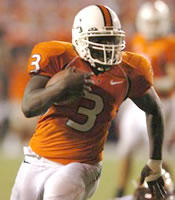Draft Pick: Frank Gore
 #65 Overall - Frank Gore
#65 Overall - Frank Gore Running Back - Miami
Height: 5-9 3/8 Weight: 217
Overview
The star running back twice returned from reconstructive knee surgery and was still considered among the top backs in the nation. Gore suffered a torn anterior cruciate ligament in his left knee in 2001 and redshirted in 2002. He returned and rushed for 100 yards in each of his first three games of the 2003 season, then tore the anterior cruciate ligament in his right knee in the season's fifth game. Determined to continue his career, Gore returned again in 2004 to rush for nearly 1,000 yards.
Gore is a breakaway threat who is also a tough inside runner, often knocking back tacklers on his way to the end zone.
Gore was one of the nation's most heavily recruited and highly regarded running backs coming out of Coral Gables High School. He set a Dade County record for rushing yardage in a season in 2000 with 2,953 yards and 34 touchdowns in his senior year. He rushed for 1,559 yards and 28 touchdowns in 1999, in addition to 301 receiving yards and four more scores through the air.
Gore showed outstanding strength and peripheral vision throughout his high school career. He was the third-rated prospect in Dade County by the Miami Herald, as well as the fourth best in Florida. Gore was listed as the best tailback on the Florida Times-Union Super 75 list and earned SuperPrep All-American. That publication also rated him the seventh best prospect overall and the top-rated running back in Florida.
As a true freshman for Miami in 2001, he totaled 562 yards with five touchdowns on 62 carries (9.1-yard avg.), the third-best season total in school history by a freshman. He spent the 2002 season recovering from knee surgery and then started the first five games of the 2003 campaign. Gore rushed 89 times for 468 yards (5.3 avg.) and four scores, adding 105 yards on 12 receptions. He tore his right knee ligament in the first half of the West Virginia game and spent the rest of the year on the sidelines.
Back on the field for the 2004 season, Gore looked to change his luck and also changed his uniform number, discarding No. 32 for No. 3. He started 11 of 12 games, lining up at tailback for 10 contests and at fullback vs. Clemson. He led the team with 945 yards and eight touchdowns on 197 carries (4.8 avg.). He also snared 10 passes for 106 yards (10.6 avg.).
In 28 games with the Hurricanes, Gore rushed 348 times for 1,975 yards (5.7 avg.) and 17 touchdowns. His 1,975 yards rank seventh on the school's career-record list and his 17 scores are tied for 10th. He also caught 23 passes for 225 yards (9.8 avg.), returned two kickoffs for 48 yards and recorded five tackles on special teams. Gore fumbled seven times, with five being recovered by the opposition. He lost 89 yards on his 348 rushing attempts.
Analysis
Positives: Has An adequate frame with solid upper body development, tight waist, good bubble and thick hamstrings Tough inside runner who finds a way to move the pile to get the yardage up the middle Can slip through the line to break tackles while maintaining balance Shows the lower-body strength to break tackles and fight for extra yardage Plays with good balance and body control after initial contact Sees the holes develop and can gain the tough yardage when the lanes are clogged by using his leg drive Has some burst to the outside and the shows the ability to work back for the ball Will play hurt Has minimum wiggle in his run, but is effective eluding defenders due to his leg strength, as he can be slippery Shows good acceleration during the first five yards on his run.
Negatives: More effective when used to move the chains rather than go for the big gainer, as he does not have the speed to bounce outside, lacking the burst to consistently reach the edge Willing blocker, but his hits pack little power and he frequently lunges at the ankles of defenders, making him of little use vs. the blitz Has to line up tighter to the line in order to gain advantage, as he does not show explosion coming out of his stance Not used much as a receiver, as he has stiff hands and will either cradle the ball or double catch Rounds his cuts and fails to defeat the press when lining up in the slot in short passing situations Has the lower-body strength to break tackles, but does not protect himself well vs. leg tackles Very low intelligence test score (6) brings concerns about his ability to digest a complicated playbook.
Post a Comment